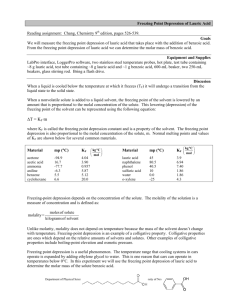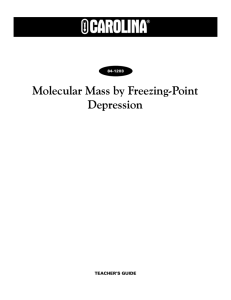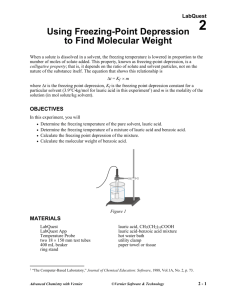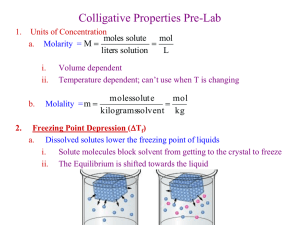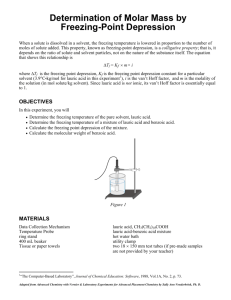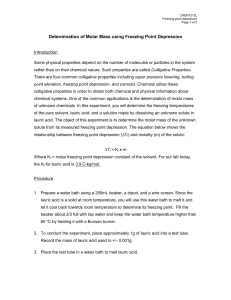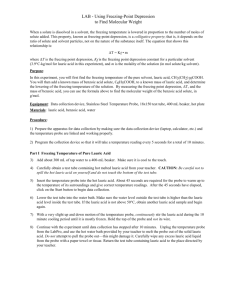Freezing Point Depression Kylie Case, Emma McKee, Rebecca
advertisement
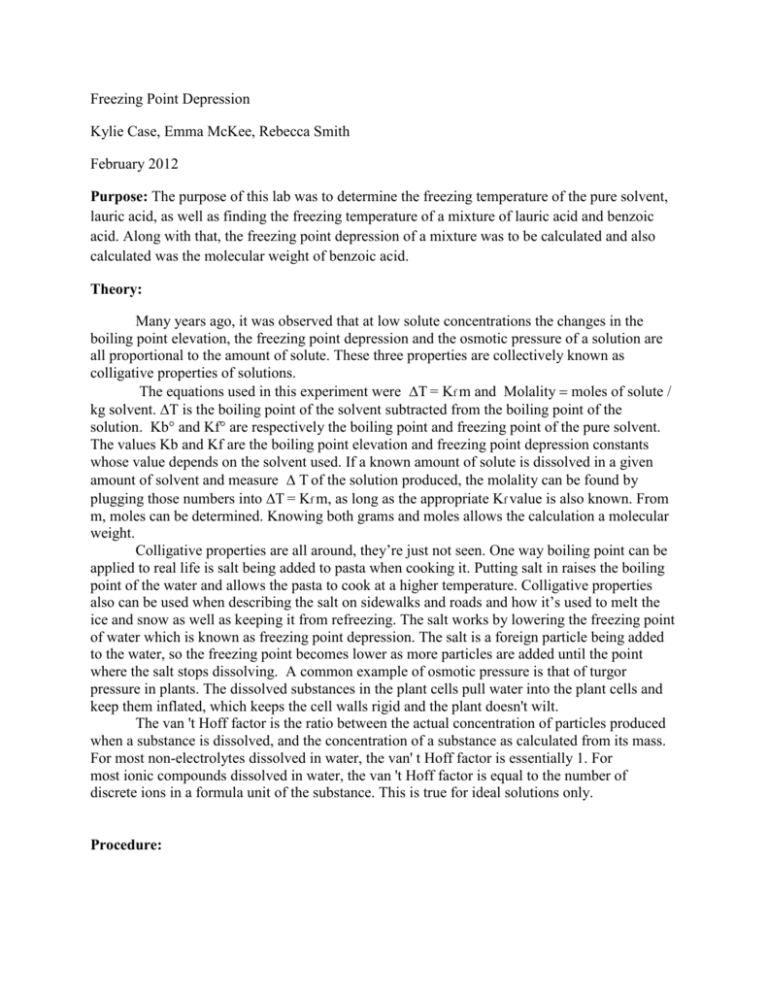
Freezing Point Depression Kylie Case, Emma McKee, Rebecca Smith February 2012 Purpose: The purpose of this lab was to determine the freezing temperature of the pure solvent, lauric acid, as well as finding the freezing temperature of a mixture of lauric acid and benzoic acid. Along with that, the freezing point depression of a mixture was to be calculated and also calculated was the molecular weight of benzoic acid. Theory: Many years ago, it was observed that at low solute concentrations the changes in the boiling point elevation, the freezing point depression and the osmotic pressure of a solution are all proportional to the amount of solute. These three properties are collectively known as colligative properties of solutions. The equations used in this experiment were T = Kf m and Molality moles of solute / kg solvent. T is the boiling point of the solvent subtracted from the boiling point of the solution. Kb° and Kf° are respectively the boiling point and freezing point of the pure solvent. The values Kb and Kf are the boiling point elevation and freezing point depression constants whose value depends on the solvent used. If a known amount of solute is dissolved in a given amount of solvent and measure T of the solution produced, the molality can be found by plugging those numbers into T = Kf m, as long as the appropriate Kf value is also known. From m, moles can be determined. Knowing both grams and moles allows the calculation a molecular weight. Colligative properties are all around, they’re just not seen. One way boiling point can be applied to real life is salt being added to pasta when cooking it. Putting salt in raises the boiling point of the water and allows the pasta to cook at a higher temperature. Colligative properties also can be used when describing the salt on sidewalks and roads and how it’s used to melt the ice and snow as well as keeping it from refreezing. The salt works by lowering the freezing point of water which is known as freezing point depression. The salt is a foreign particle being added to the water, so the freezing point becomes lower as more particles are added until the point where the salt stops dissolving. A common example of osmotic pressure is that of turgor pressure in plants. The dissolved substances in the plant cells pull water into the plant cells and keep them inflated, which keeps the cell walls rigid and the plant doesn't wilt. The van 't Hoff factor is the ratio between the actual concentration of particles produced when a substance is dissolved, and the concentration of a substance as calculated from its mass. For most non-electrolytes dissolved in water, the van' t Hoff factor is essentially 1. For most ionic compounds dissolved in water, the van 't Hoff factor is equal to the number of discrete ions in a formula unit of the substance. This is true for ideal solutions only. Procedure: Get goggles and put them on. Connect a Temperature Probe to Channel 1. Start Logger Pro and open the file “04 Freezing Point” from the Advanced Chemistry with Vernier folder. Next, add around 300 mL of tap water with a 20-25 C temperature into a 400 mL beaker, then putting it on the base of the ring stand. Use the utility clamp to get a test tube with the hot, melted lauric acid in it. Put the temperature probe in the lauric acid and secure the utility clamp to the ring stand. Lower the tube into the water making sure the water level outside the test tube is higher than the lauric acid level on the inside. Stir the acid up and down for 10 minutes. After the data collection, use a hot water bath to melt the lauric acid enough to remove the temperature probe. Find the freezing temperature by mean temperature on the graph that had a fairly constant temperature. Prepare computer for data collection. Get a test tube with the melted solution with about 1 g of benzoic acid dissolved in about 8 g of lauric acid. Record the exact masses of the benzoic acid and lauric acid as it says on the test tube. Data: Trial 1: Mass of pure substance Trial 2: Mass of solvent Trial 2: Mass of solute Trial 1: Freezing Temperature of pure solvent Trial 2: Freezing Point of the mixture Not Required 7.46 g 1.32g 43.13°C 36.63°C Calculations: 1. Molality T = Kf m T = 43.13°C-36.63°C T=6.5°C 6.5=(3.9 °C kg/mol)(m) m= 1.67 mol/kg 2. Moles of Benzene m=moles of Benzene/kg lauric acid 1.67=moles of Benzene /.00746 Moles of Benzene=.0125 moles 3. Experimental Molar Mass mm= mass benzoic acid/moles benzoic acid mm= 1.32g/.0125 moles mm= 106g/mol 4. Actual Molar Mass C7H6O2 C=12.011*7 H=1.0079*6 O=16.00*2 122.1244g/mole 5. Percent Error Actual – Expected /Actual *100 106-122.1244* 100 122.1244 Percent Error=13.2 % Graphs: Error Analysis: One source of error could have been the valleys in the graph of lauric acid. This is a systematic error that would have caused the temperature to be lower than it should have been. The mean temperature was found by using the Statistics button, and the valleys were included in the section. This could be corrected by bracketing out off the section that did not include the valley . Another source of error could have been the preparation of the solution. The Benzoic Acid was already made. As it is, Benzoic Acid decreases the freezing point, therefore if there was excess acid or more than labeled, that would decrease the freezing point depression more than it should be, ultimately increasing the percent error. This source of error is also systematic since it alters the data in one specific direction. Conclusion: The purposes of the lab were met because the freezing temperature of the pure solvent, lauric acid and the freezing temperature of a mixture of lauric acid and benzoic acid was found. Also, the freezing point depression of a mixture was calculated and also calculated was the molecular weight of benzoic acid. The Molar Mass of Benzoic Acid was found to be 106 g/mol and the percent error was 13.2%. The freezing point of lauric acid and benzoic acid was successfully found using the graph. Also, the freezing point depression of the solution was able to be calculated using the data collected. Questions: T = Kf m 5.0 °C=(0.51)(m)(2) m= 4.9 mol/kg m=moles solute/kg solvent 4.9=moles of solute/ 2.00 kg H2O Moles of solute = 9.8 moles 9.8 moles=58.433g/1 mole=570g 76.


